Māori land march
| Māori Land March | |
|---|---|
| Part of Māori protest movement | |
 The Land March arriving at Parliament | |
| Date | 14 September to 13 October 1975 |
| Location | |
| Caused by | Land alienation and cultural loss |
| Methods | Marches, direct action |
The Māori Land March of 1975 was a protest led by the group Te Rōpū Matakite (Māori for 'Those with Foresight'), created by Dame Whina Cooper. The hīkoi (march) started in Northland on September 14, travelled the length of the North Island, and arrived in Wellington on October 13, 1975.[1]
Background[]

In 1953, the government under Prime Minister Sidney Holland forced the Maori Affairs Act to use so-called unproductive Māori land. Anyone who wanted could now report unused land to the Māori Land Court and apply to borrow the land through an appointed trustee. The Maori Affairs Amendment Act 1967 introduced compulsory conversion of Māori freehold land with four or fewer owners into general land. It increased the powers of the Maori Trustee to compulsorily acquire and sell so-called uneconomic interests in Māori land. Māori worried that the law would result in further alienation of what land remained. As the protests increased, the Māori realized that the New Zealand Māori Council , which had existed since 1962, and the Māori Women's Welfare League, founded in 1951, were not strong enough to represent their rights and political demands as their previous advocacy groups.[2]
In early March 1975, a Hui (congregation) was called at Te Puea Memorial Marae in Māngere Bridge, with 79-year-old Whina Cooper present . Cooper had earned much recognition and respect over the many years of her social and political engagement among the Māori and was one of the few women in the Māori community recognized as a leader. The idea of a ‘Maori Land March’ from Te Hapua in the far north to Parliament was discussed. The aim would be to dramatise the entire package of Maori demands and aspirations which had yet to be addressed. The march would focus on the most iconic element of Maori losses and hopes: the land. The planned land march would combine the forces of Nga Tamatoa (The Young Warriors) type radicalism with the wishes and protocols of traditionalist elders, attracting the support of Maori from both urban areas and rural Marae throughout the country. The march was to be focused on the ‘twin themes of landlessness and cultural loss’.[3] The following four months were used for planning and fundraising. In August all preparations were made and support and accommodation provided at the various marae .
The March[]

Fifty marchers left Te Hāpua in the far north on 14 September for the 1000-km walk to Wellington. Led by 79-year-old Cooper, the hīkoi quickly grew in strength. As it approached towns and cities, local people joined to offer moral support. The marchers stopped overnight at different Marae, on which Cooper led discussions about the purpose of the march. Leaflets were distributed explaining why the march was required titled 'Why We March.'

The march, accompanied by two trucks and a bus, led in 29 days from Te Hapua; Kaitaia; Mangamuka; Otiria; Hikurangi; Waipu; Wellsford; Orewa; Auckland; Ngāruawāhia; Kihikihi; Te Kuiti; Taumarunui; Raetihi; Whanganui; Ratana; Palmerston North; Shannon, New Zealand; Ōtaki, New Zealand; Porirua to Wellington.
Impact[]
Upon arriving at Parliament, Whina Cooper presented a petition signed by 60,000 people from around New Zealand to Prime Minister Bill Rowling. The petition called for an end to monocultural land laws which excluded Māori cultural values, and asked for the ability to establish legitimate communal ownership of land within iwi. The hikoi represented a watershed moment in the burgeoning Māori cultural renaissance of the 1970s. It brought unprecedented levels of public attention to the issue of alienation of Māori land, and established a method of protest that was repeatedly reused in the following decades, such as the occupation of the land at Bastion Point.[4] This action brought treaty issues to public attention more strongly than at any time since the 19th century.
Gallery[]
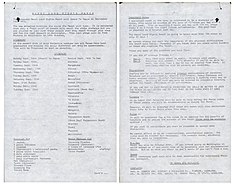
Instructions to participants
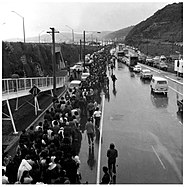
March on New Zealand State Highway 1 in Wellington
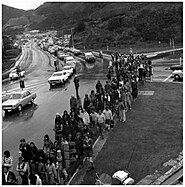
March travelling down Ngauranga Gorge, Wellington
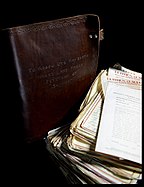
Petition presented to Parliament by Whina Cooper
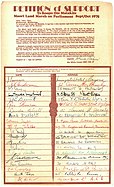
A petition sheet
References[]
- ^ "Whina Cooper leads land march to Parliament | NZHistory, New Zealand history online". nzhistory.govt.nz. Retrieved 2019-12-15.
- ^ "Treaty events since 1950 - Treaty timeline | NZHistory, New Zealand history online". nzhistory.govt.nz. Retrieved 2019-12-15.
- ^ "The Maori Land March | NZETC". nzetc.victoria.ac.nz. Retrieved 2019-12-15.
- ^ Collins, Mikaela (2015-09-14). "Maori land march - 40 years on". ISSN 1170-0777. Retrieved 2019-12-15.
External links[]
The march was documented in Te Matakite o Aotearoa - The Māori Land March a film available via New Zealand on Screen.
- Māori history
- 1975 in New Zealand
- 1975 protests
- Māori politics
- Protests in New Zealand
- Protest marches




